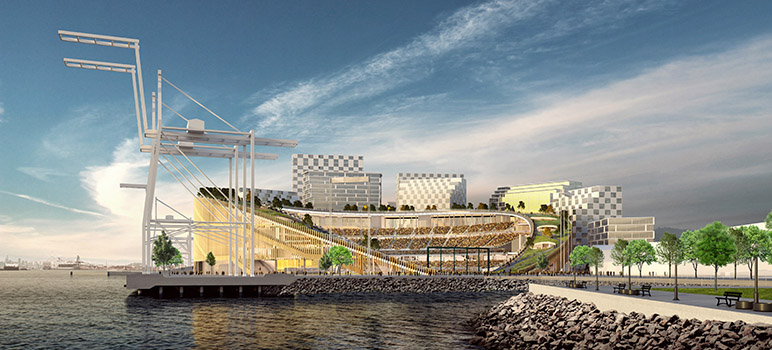With the major league baseball regular season drawing to a close, many Oakland Athletics fans are hoping that they'll have a new ballpark on the waterfront in a couple of years.

Artist rendering of the proposed new waterfront stadium for the Oakland A’s on land currently serving the Port of Oakland’s Howard Terminal. Image courtesy of Big – Bjarke Ingels Group
BY PATRICK BURNSON
Published: September, 2019
With the major league baseball regular season drawing to a close, many Oakland Athletics fans are hoping that they’ll have a new ballpark on the waterfront in a couple of years. The team has even gained the Port of Oakland Board of Port Commissioners’ unanimous approval to an exclusive negotiating term sheet.
Still, the port’s cargo division has expressed its concerns about the impact of the project on port operations, and has ongoing meetings with all stakeholders scheduled to take place this fall.
The Athletics plan to develop 3.3 million square feet of housing, 1.5 million square feet of commercial and office space, a hotel and a performance center in the area surrounding a new stadium on property currently serving the port’s Howard Terminal.
A new study prepared by the consultants Tioga Group and Hackett Associates for the San Francisco Bay Conservation and Development Commission (BCDC) warns that plans to accommodate a new generation of megavessels may be at risk if the port loses acreage intended for a new turning basin on the property.
The report, titled “Bay Area Seaport Forecast,” examines our region’s ocean cargo gateways for throughput and capacity. It says that the 50-acre Howard Terminal site “is below the current standard for new container terminals, but may be a necessary increment to seaport capacity under moderate-to-strong cargo growth scenarios.”
And as we’re well aware, Bay Area shippers care less about baseball season than peak season.
“There has been a recent downward trend in U.S. West Coast shares of total U.S. container trade and of transpacific container trade,” said Tioga’s principal, Dan Smith. “The Port of Oakland handles nearly all containerized imports and exports for Northern California, as well as some intermodal cargo moving to and from inland points. Oakland competes for different trade flows in different ways.”
For example, Oakland competes for Asian imports to Midwestern consumer markets with the ports of Los Angeles and Long Beach. For exports, Oakland’s geographic position near California agricultural production gives it an advantage. “Oakland is also often the last port of call before vessels return to Asia, providing a later and faster shipping option for exporters,” said Smith. “As a result, Oakland is one of few U.S. ports where containerized exports often exceed imports.”
Karen Vellutini, a vice president with Oakland-based Devine Intermodal and author of a monthly newsletter, recently stated her opposition to the ballpark. “We don’t believe 3,000 to 4,000 homes, small watercraft, personal vehicles, pedestrians and added congestion are congruent with maritime operations,” she said.
While the Athletics have four years to complete an environmental impact report, negotiate lease terms with the port and secure additional regulatory approvals, the organization has stated that is has plans to break ground next year.
“The Oakland A’s may think they have hit a home run, but the industry is far from throwing the game,” said Vellutini. “We are still swinging for the fences.”
Conference to Focus on Blockchain Initiatives
When Bay Area shippers convene in San Francisco for Oracle OpenWorld this month, much of the talk will be about new ocean carrier blockchain initiatives.
Oracle has recently collaborated with CargoSmart in what it is calling a “significant milestone” in forming the Global Shipping Business Network (GSBN) blockchain consortium. Nine leading ocean carriers and terminal operators signed a service agreement with CargoSmart earlier this year to commit to provide resources to establish a not-for-profit joint venture to accelerate the digital transformation of the shipping industry.
The signatories of the GSBN Services Agreements plan to complete the establishment of the GSBN in early 2020, subject to obtaining all requisite antitrust, competition and regulatory approvals. Meanwhile, CargoSmart will continue to run pilot applications to prove the viability of the GSBN and demonstrate the high potential value creation through the GSBN.
And Oracle continues to support CargoSmart with a capable blockchain platform for decentralized consortium governance, on-chain mechanisms for business confidentiality, and performance at scale required for tens of millions of shipments that underpin world trade.
“Together CargoSmart and Oracle have been working on this effort for almost a year,” said Frank Xiong, Oracle’s vice president for blockchain product development. “From the outset, the foundation of this approach has been a decentralized, multi-party, fully managed enterprise-grade blockchain network that enables trust, while maintaining confidentiality of the commercial relationships as required by shipping industry regulations.”
He added that by speeding up the deployment of the initial pilot applications based on the platform’s rapid development and integration capabilities, CargoSmart has moved through quick innovation cycles to respond to “members’ priorities.”
Patrick Burnson is the executive editor of Logistics Management. www.logisticsmgmt.com

